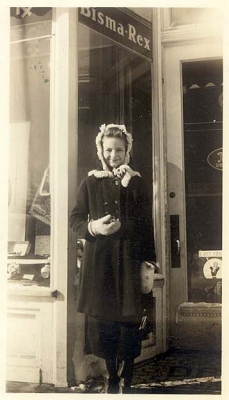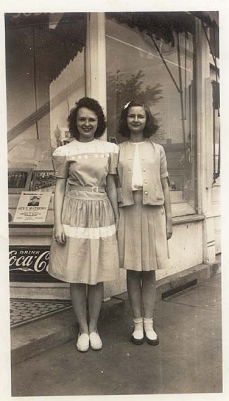

The Mathews' Drug Store


The Mathews' Drug Store
"Behind the Counter"
by
Marilyn Mathews Lambert
My name is Marilyn Mathews Lambert. My parents, Lester Gail and Ruth Mathews, and I arrived in Winfield from Hedrick, Iowa, when I was twenty months old. It was November 1931.
Tingle Warren, a Winfield bank employee, had a sister-in-law, Selma, who was married to Hedrick physician Dr. Rex Henry, who had delivered me and later my sister. When the drug store in Winfield was looking for a new proprietor, Tingle Warren contacted my father who was working for his father as a pharmacist at the time.We bought the contents and fixtures. There was no fountain. My father bought a new ice cream fountain for the store.
The big twin display windows faced east and much time was spent raising and lowering the awning to protect from fading whatever was in the window. You never see an awning anymore. They were expensive.
In Summer there was a screen door and big heavy wooden door. On summer nights Mormon flies were real pests on that screen and we were open six nights a week. Daddy stayed open til after the movie or the "traders" went home on Saturday and Wednesday nights. He loved his store and loved to be there.
There was a big coal furnace in the basement. Ivan Lee would go to the store early in the morning, sweep the floor, mop the tile middle floor and "fix" or feed the coal furnace. It was constant hard work to keep the coal furnace at home and the store burning.
There were three large rooms in the store. The front was for customers and soda fountain. Middle room was storage, wallpaper, pharmacy and office. We called it the "back room," but there was a huge unheated back room on the alley. Storage and barrels of veterinary medicines were stored there.
As you stepped in the front door, many aromas were noticed. First on the right were the magazine racks, then a big curved glass counter containing cigars, then a hot nut case, then cosmetics and perfumes. On the left the fountain and booths reached the cash register. Behind the counter were oiled hardwood floors (easy on the feet). On the walls were beautiful shelves and drawers. You were "served" back then. The clerk helped you by getting things for you and weighing them. They were kept behind the counter. I remember one thing there. Alum was in a drawer in rock form. It was used when making pickles. Now I know why the old recipes call for a lump of alum the size of a walnut. Much was weighed and labeled - liquids, too. We had many stickers that said, "Mathews' Rexall Drug Store" and the contents. We had many glass bottles of all sizes.
The "old folks" were thrilled when a barrel of packed Horehound candy appeared for sale.
There were two beautiful mirrors, one on the north and one on the south wall. Push them up and there was more storage behind.
At the main cash register were the veterinary supplies. We carried all medicines for farm animals. There were rubber nipples for orphaned lambs. Huge syringes. Pearl Lowe said, "We sold a lot of blue vitriol! I don't know what it was for." Does anyone here know?
I was in front of the counter most of the time, except when I went snooping. I had a lot of sore throats as a child. We had a patent medicine called "tonsiline." It had a picture of a giraffe on it. "It will coat your throat all the way down, even if you are a giraffe." It turned a spoon black.
We sold "Fern" chocolates. I think we got them in Burlington. Mother considered them the best. We had a poison register. Everyone who bought signed it.
There weren't many sacks in those days. We had a huge roll of light blue paper. On it read "Mathews' Rexall Drug Store." I thought it was pretty. It was used with matching paper tape. We had a porcelain roller to wet the back. The counter was crowded with also a large scale.
There was a partial wall separating the front of the store from the middle room. We called it the "back room" but there was another big back room back of it. In the middle back room was a huge can that held medicine, bottles, stickers and corks. Nearly everything back there was sold by the ounce with the name of the contents and the store name. There was a large sink on the north wall. It was pitted and gray. There was one faucet of cold water. On the northwest corner was a place to "show" wallpaper. The customer would sit on wooden lawn furniture, which my grandpa Bennet made and a clerk would slowly turn the pages of the wallpaper book.
On the south side was a big old safe, a huge roll-top desk, and racks to hold boxes of extra merchandise. During World War II there was a little kerosene burner where Daddy mixed syrup for the soda fountain.
The big back room was always too hot or too cold. The ceiling was two stories high. There was more storage, some wallpaper and paint, and a large loading dock. On the dock were large barrels of mysterious stuff. The barrels lay on their sides and had spigots in them. We would tease my father about smelling like "hog dip." Guess it was hard to wash off. He had a big funnel and filled gallon jugs with the mysterious stuff. There was a big long table with a wallpaper trimmer bolted on one end. The handle was turned by hand and the blade cut the unwanted side of the wallpaper. I think it was made that way so the nice edge wasn't tattered.
The day the traveling salesman came was always special and set aside for just that. He was taken to the cafe for lunch and became a good friend. When Cy Young of Burlington died of lung cancer, we stopped selling cigarettes. We had a "want book." Things we were low in stock.
Forgot the soda fountain.
The fountain was the showplace of the store. There was a large plate glass mirror on the south wall. Under that was a shelf and more drawers and storage beneath. On the shelf were the dishes used in the fountain, powdered malt, a bottle of phosphate, malt electric mixers and a small cash register. In the drawers were harmonicas, violin strings, uke and banjo strings. Also resin for violin bows. The fountain was about ten feet from the front door. In there was a small "deep freeze." It contained packaged ice cream, frozen candy bars and frozen novelties. The bar was black marble or glass, the facing of the bar was cream colored ceramic tile. The stools were comfortable. I ought to know. There was a brass foot rail, padded cushions on the stools with back of woven metal. They swiveled and were usually painted blue and orange, Rexall colors.
Every Monday it was Pearl Lowe's job to wash the fountain. On the working side of the fountain were many things. There was a small chrome sink, one continuous deep freeze where the ice cream was kept. It was so deep there was another batch of ice cream under the top. Daddy made his own ice. It chipped very fine and made a very good coolant. Above the ice cream was a row of porcelain and chrome containers. They contained chocolate, cherry, lemon, and coca cola syrup. The rest had little dippers and were crushed pineapple syrup, butterscotch, strawberry and marshmallow. Nuts were kept somewhere around there. In the middle were two big spigots. Both delivered carbonated water from the basement. One made a soda foam if you pushed it backward.
I think mother loved "trimming" the windows. I think my favorite was the graduation pictures of that year's class. This is where the awning became important. Daddy spent a lot of time lowering and raising the awning to keep the sun from fading things we would sell later.
We had a coal furnace in our home and store. When I got old enough I "fixed" the furnace. The coal came in really big chunks and Daddy broke it with an ax.
There was a great flurry of excitement at 1 cent sale time. A great amount of boxes arrived. They had to be checked and counted. Now as much as possible was on the counter. All were Rexall products. You buy one product at regular price, then get a second of the same for 1 cent. This sale was very popular.
We had hired girls for five years that lived with us all week. They went home late Saturday night and returned Sunday night. Our last was in 1943 when I was thirteen. We were old enough to stay alone. But during the sale we were shipped off to Hedrick and Grandpa and Grandma Bennetts.
When the sale bills arrived, they were flat. We four sat down in the booths to fold them. I used my Dad's big heavy pocket knife to crease them flat. Glen Swearingsen always put them in his big canvas bag and left them at every house in Winfield. I think the drug company printed them.
We carried a full line of cosmetics. They were the Rexall brand Cara Nome (meaning "dear name") I love the scent and I used it til I couldn't find a Rexall Store. Once or twice a cosmetologist came for a few days to give facials and sell the product. She smoked and we thought she was really "sophisticated."
My mother worked but we knew where we could see them any time. We were never told to go home and were allowed to snoopy anywhere.
After the last hired girl left, the movie was our "safe place to be." After the show, we waited at the store til we closed - after the movie crowd.
My father really loved his store. We only saw him at meals and part of Sunday. The law said he had to be open every day. He was there from opening (I don't know the time) til the movie crowd went home. There was no movie Thursday, so he must have been home earlier.
The story of the drug store ended February 17, 1948. My father was 43 when he died of an enlarged heart.